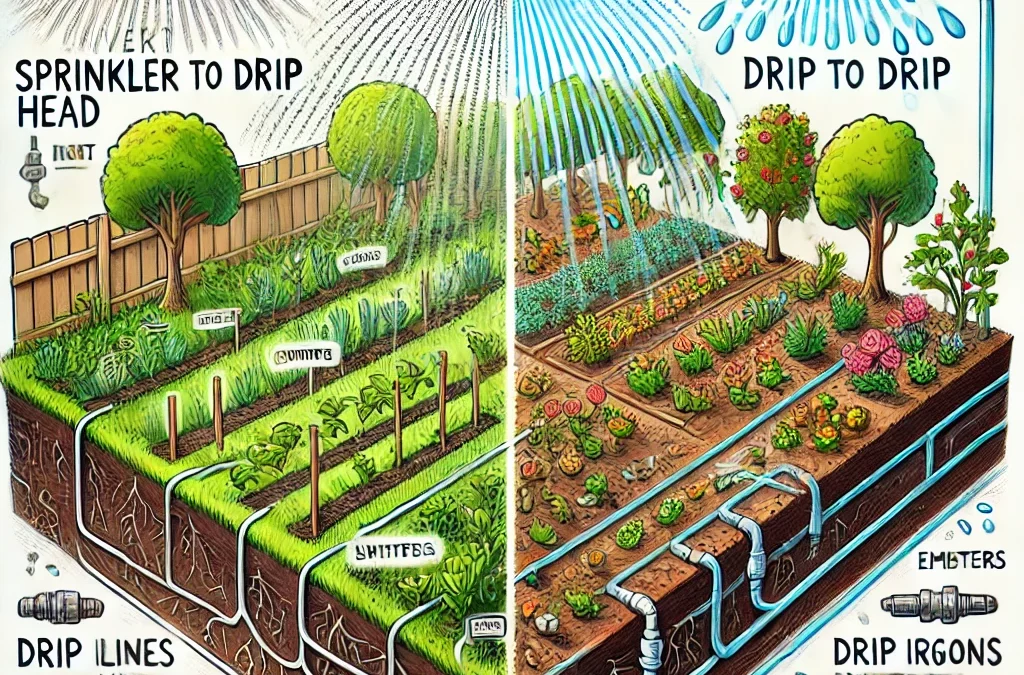Convert Sprinklers to Drip: A Smart Move for Garden Efficiency and Sustainability
Are you looking for a smarter way to water your garden beds in Seattle? Converting sprinklers to drip irrigation is a simple yet impactful upgrade that can dramatically improve water efficiency, plant health, and overall sustainability. While sprinkler systems are great for lawns, drip irrigation is the gold standard for garden beds, shrubs, and perennials.
In this article, we’ll explore what it means to convert sprinklers to drip, why it’s worth doing, how the process works, and why it pays to work with a sustainably focused irrigation professional—especially here in the Pacific Northwest. If you are already convinced you need to convert your sprinkler system to drip, reach out here on our Irrigation Services page.
What Does It Mean to a Convert Sprinklers to Drip?
Converting a sprinkler system to drip irrigation involves replacing traditional spray heads (used for lawns) with low-pressure drip tubing or emitters that deliver water slowly and directly to the root zone of plants. Instead of spraying water over a large area, drip systems apply moisture exactly where it’s needed, minimizing waste and maximizing plant uptake.
This kind of conversion typically involves:
- Capping off or converting each sprinkler head
- Adding a filter and pressure regulator to each converted zone
- Installing drip tubing and/or individual emitters tailored to plant needs
Why Convert to Drip for Garden Beds?
1. Water Efficiency
Numerous studies have shown that drip irrigation can reduce water usage by 30% to 70% compared to traditional sprinklers. According to the EPA WaterSense program, drip systems lose less water to evaporation and runoff, making them one of the most efficient irrigation methods available.
2. Better Plant Health
Because drip systems deliver consistent moisture directly to the soil, plants are less likely to experience stress from overwatering or underwatering. This is especially important in garden beds with diverse plantings that have different water needs.
3. Weed and Disease Reduction
Since water is applied only to the root zones, weed seeds between plants stay dry and are less likely to germinate. Wet foliage—common with sprinkler systems—can also promote fungal diseases, especially in the damp Seattle climate. Drip irrigation helps reduce these risks.
4. Sustainability
Seattle’s water supply is precious. By switching to drip in non-lawn areas, homeowners can significantly reduce outdoor water use, helping conserve resources and lower utility bills while supporting local efforts to maintain a healthy urban environment.
How to Convert Sprinkler Systems to Drip
The process of converting a sprinkler zone to drip irrigation requires attention to detail and the right components. Here’s a step-by-step overview:
1. Evaluate the Existing System
Start by identifying which sprinkler zones cover garden beds. These are the best candidates for conversion. Lawn areas should continue using sprinklers optimized for turf coverage.
2. Cap Off Each Head
Every sprinkler head in the converted zone must be capped off. There are some retrofit drip adapters but we have seen quality issues with them, here is an example of a nicer one, but we still recommend against them. They are a bandaid and don’t address the fundamental design issues between sprinklers and drip. Skipping capping the heads can lead to wasted water and pressure issues.
3. Install a Filter and Pressure Regulator
This is essential. Drip irrigation systems operate best at low pressure (typically 20–30 PSI) and are prone to clogging without filtration. Installing a pressure regulator and filter at the beginning of each drip zone ensures system longevity and consistent performance.
4. Lay Out Drip Tubing or Emitters
Use drip tubing (with inline emitters) or install individual emitters at each plant. This should be tailored to the plant types, spacing, and sun exposure in your garden. Mulching over the tubing can help retain moisture and protect the lines.
5. Test and Adjust
Run the system and inspect for leaks, clogs, or uneven distribution. Make adjustments as needed and set an appropriate irrigation schedule—usually less frequent but longer watering times than sprinklers.
Why Hire a Sustainably Focused Irrigation Professional?
While DIY kits exist, converting a sprinkler system to drip irrigation is more than a weekend project—it’s an investment in the health and efficiency of your landscape. A sustainable irrigation professional will:
- Design a drip system tailored to your unique garden layout that lasts. DIY kits typically end up in a landfill a few years down the road.
- Ensure all technical elements (filters, pressure regulators, flow rates) are properly installed
- Follow Seattle-specific best practices for water conservation
- Identify opportunities to improve your entire irrigation system’s efficiency
Working with an expert who understands the balance between plant health, water conservation, and long-term performance ensures that your system not only works—it thrives.
Final Thoughts
Switching from sprinklers to drip irrigation in your garden beds is a smart, eco-conscious choice for Seattle homeowners. With benefits ranging from water savings to healthier plants and fewer weeds, this upgrade aligns beautifully with sustainable landscaping principles. Just make sure it’s done right—with pressure regulation, filtration, and proper capping of existing heads—preferably with the help of a local irrigation professional committed to sustainability.
Click here to go back to our Blog Page
Click here to go back to our company Home Page
Contact Us for more information!

